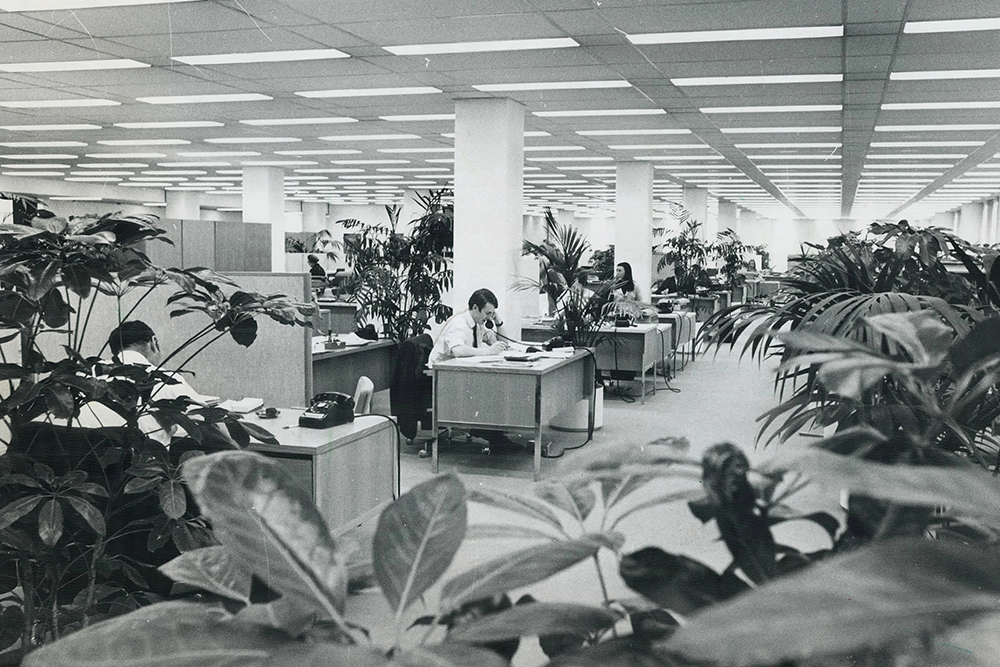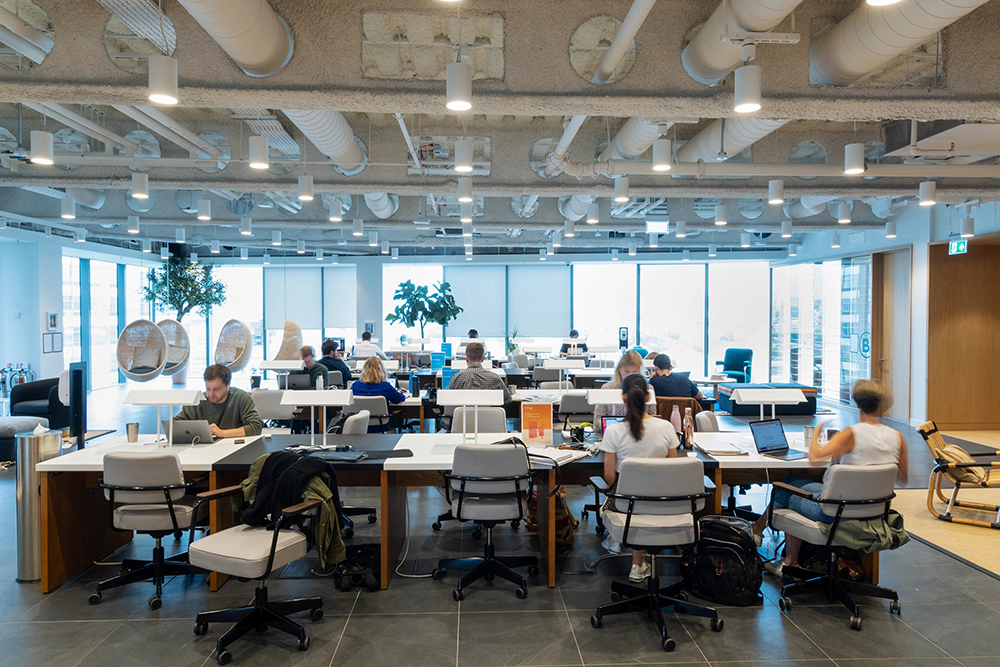办公室的历史
我们都知道有关办公室的刻板印象。
甚至有一部与办公室有关的长篇情景喜剧,讲述了两位上班族、美国的国民情侣吉姆和帕姆分分合合的浪漫故事。但大多数白领对办公室环境并没有温馨、友善的感觉,他们的记忆中只有一排排开放的办公桌和饮水机旁的闲聊。人们对办公室的感受更多的是或爱或恨,或者由爱生恨。
新冠疫情期间的电视剧对办公室的描述则充斥着黑暗和阴森的氛围,比如《人生切割术》(Severance)或者《新创玩家》(WeCrashed)等。这种变化值得关注,因为《办公室》(The Office)是对许多白领枯燥空虚的办公室生活的颂歌。而现在与以前的主要区别在于:工作不会自然而然地意味着通勤到办公室,而且随着办公室重新开放,它也不再是以前的样子。
办公家具制造商MillerKnoll的全球研究与洞察副总裁瑞安·安德森说:“我想大多数人不会质疑办公室应该是什么样子,直到他们长达一年被禁止进入办公室。”
跨国设计公司帕金斯-威尔建筑事务所(Perkins & Will)的设计总监兼主管米娜·克雷内克认同这种观点。她表示:“这是一个非常关键的时刻。员工这一次拥有比以往任何时候更大的话语权。你以为为什么会发生‘大辞职潮’(Great Resignation)?因为雇主不支持员工的生活方式。”
既然在新冠疫情之前没有人喜欢办公室,而且除了高管(实话实话,他们拥有最好的办公环境)以外也没有人愿意回到办公室,办公空间将会如何演变?有没有可能重新改造办公室,让人们真心希望在这里工作?
为了预测办公室文化的发展方向,《财富》杂志回顾了今天的办公室文化如何诞生,以及我们想要什么样的办公室。为了分析在格子间之后,办公室将会走向何方,首先得弄清楚格子间的由来。
Wi-Fi和大型科技公司丰厚福利的双刃剑
安德森称,当公司为了增加协作(和节约资金)开始拆除格子间时,成排办公桌的设计似乎很激进,但这种开放式办公室格局实际上诞生在格子间出现之前。
20世纪50年代,德国一场名为“Bürolandschaft”的设计运动,拒绝了办公室应该千篇一律的观念,更加重视舒适度。这场运动可以直接翻译成“办公室景观”。开放式办公时代的特征是,专注于创建更自然的布局,用绿植或屏幕分隔空间。

但20世纪60年代末台式机的出现,让办公室布局发生了巨大变化。安德森解释说,之后30年,电脑和电话成为办公室工作的核心,空间设计也开始围绕这种固定技术的需求展开。
“我们现代对于工作的设想,如需要在办公室完成知识工作,需要在办公桌上完成自己的工作,基本上都是那个时代的写照。”安德森指出,大约15年后,快速的技术发展,使这种物理环境落伍,尤其是2004年和2005年Wi-Fi技术的出现,“但这些设想依旧存在。”
科技公司最终推动办公室步入了新时代。国际WELL健康建筑研究院(International WELL Building Institute)的总裁兼首席执行官瑞秋·霍奇登指出:“从许多方面来说,我们应该感谢硅谷发起了健康职场和以人为本空间运动,因为硅谷公司开始在办公室里布置休息舱、滑板车、攀岩墙和无限量供应食物的餐厅等。”
但这是一把双刃剑:安德森认为,这种精心设计的办公空间“有一种潜在的预期,即希望人们在这里花费大量时间。”
而且这种宽敞的开放办公空间有一些令人烦恼的缺点。员工可能实际上紧邻而坐,很难找到打电话或召开敏感会议的个人空间,还有太多让人分心的因素。突然之间,人们开始想念格子间。
在新冠疫情爆发之前,公司高管不知道应该如何在格子间文化和开放式办公室设计之间取得平衡。恢复现场办公的趋势和大辞职潮,终于给雇主带来了压力,迫使他们必须开发员工真正喜欢的办公室布局。
办公室变得更灵活,密度下降,采用社区型布局规划
新冠疫情已经持续了两年,公司希望重新布置办公室空间,以鼓励员工重回办公室。许多公司选择直接询问员工的需求和期待。
商业地板公司Interface在2021年进行了一次调查,调查结果令该公司的工作/生活与职场策略总监达比·格雷西非常意外。
格雷西说:“人们最想念的是同事,但他们最担心的也是同事。”
一种新的解决方案就是所谓的“社区型布局规划”理念。办公室采用这种设计,既提供了同事之间交流的空间,又保证了员工在需要更专注地工作时能够躲到僻静场所的灵活性。安德森解释称,办公室变成了共享办公桌、格子间和电话间的混合体,可以在开放式办公与个人空间需求之间达到平衡。这意味着办公室空间变得不像以前那么呆板,更像是家中的环境。
格雷西表示,最初,出于疫情防控的需要,Interface采用了这种社区型布局,以防止人员聚集,但他们很快意识到,用这种方式能够很好地保证员工在办公室里的交流。

WeWork的全球设计总监艾比·维斯卡尔沃说:“未来的办公室关键在于灵活性。”应该由公司自己决定哪一种办公室布局最适合自己的团队。
提供硅谷式的办公室福利,比如康普茶或海洋球等,对员工的吸引力不及具有包容性的办公空间,因为后者更有利于完成工作。
格雷西称:“我并不认为这种噱头一样的福利,可以持续吸引员工留在办公室。”相反,Interface在办公室里添加了员工在居家办公期间享受到的福利。例如,员工在居家办公期间,喜欢挤出时间健身,于是Interface为办公室购置了互动健身平台Peloton。
雇主还在想方设法利用空间,满足不同员工的多样化需求。比如,安德森发现,有公司改造了健康空间以满足各种需求,例如有的新手妈妈需要吸奶,有神经多样性员工需要安静空间,或者有色人种员工希望摆脱语码转换休息一下等。
霍奇登表示:“我们必须考虑如何保证办公室设计的公平性。你的设计不能围绕中间派展开,而是应该针对极端情况进行设计。”
现代办公室将环境优美且功能齐全
霍奇登指出:“所有人面临的一个共同问题”很简单。“要求人们重回办公室,如何提高他们的积极性和工作效率,如何让他们变得更健康、更开心。”
克雷内克将新时代的办公室布局比作了酒店业,“雇主作为主人招待员工。”
克雷内克表示:“办公室确实非常重要。但它与传统办公室截然不同。它更像是酒店大堂,能够成为雇主自夸的卖点。”
维斯卡尔沃认为,灵活性和优美的环境相结合至关重要。维斯卡尔沃解释称,办公室设计将变得更以人为本,公司希望设计可以鼓励协作和提高员工积极性,同时为员工提供他们所需的工具。维斯卡尔沃表示,传统办公室设计使用乏味的预制家具,翻新需要大量投资,这种新潮流给这些办公室带来了挑战。

克雷内克称,客户不再像以前一样要求她模仿谷歌(Google)设计他们的办公室;他们正在努力了解员工的需求和期待。办公室布局讨论中,会邀请人力资源代表参与。办公室翻新并没有“一刀切”的方案,如果一家公司的办公室看起来与竞争对手一模一样,它将会落伍。
Industrial Facility的设计师金·科林说:“原因很简单:缺乏创意的办公室将无法吸引到有创意的人才。”
办公室正在变成提供实用的便利设施的场所,因为公司能够提供员工家中没有的技术和工具,比如打印机和良好的Wi-Fi等。克雷内克表示:“我认为办公室正在成为员工做好本职工作的资源中心。”
安德森将办公室和家的差异,比作餐厅和自家厨房的差异。两者不应该是竞争关系,理想情况下两者可以互补。他认为,办公室必须成为“一种按需提供的资源,补充居家办公的不足。”
离开办公室的这段时间让员工明确了自己的需求,而紧张的劳动力市场也让他们有能力促使雇主倾听他们的需求。办公室濒临消失的时代,为刺激创新创造了可能性。
安德森补充道:“给予员工自由,允许员工不必在办公室工作,才是更合适的选择,因为这样可以让办公室不再是摆满办公桌的无聊空间,而将成为人们真正喜欢的场所。”(财富中文网)
译者:刘进龙
审校:汪皓
我们都知道有关办公室的刻板印象。
甚至有一部与办公室有关的长篇情景喜剧,讲述了两位上班族、美国的国民情侣吉姆和帕姆分分合合的浪漫故事。但大多数白领对办公室环境并没有温馨、友善的感觉,他们的记忆中只有一排排开放的办公桌和饮水机旁的闲聊。人们对办公室的感受更多的是或爱或恨,或者由爱生恨。
新冠疫情期间的电视剧对办公室的描述则充斥着黑暗和阴森的氛围,比如《人生切割术》(Severance)或者《新创玩家》(WeCrashed)等。这种变化值得关注,因为《办公室》(The Office)是对许多白领枯燥空虚的办公室生活的颂歌。而现在与以前的主要区别在于:工作不会自然而然地意味着通勤到办公室,而且随着办公室重新开放,它也不再是以前的样子。
办公家具制造商MillerKnoll的全球研究与洞察副总裁瑞安·安德森说:“我想大多数人不会质疑办公室应该是什么样子,直到他们长达一年被禁止进入办公室。”
跨国设计公司帕金斯-威尔建筑事务所(Perkins & Will)的设计总监兼主管米娜·克雷内克认同这种观点。她表示:“这是一个非常关键的时刻。员工这一次拥有比以往任何时候更大的话语权。你以为为什么会发生‘大辞职潮’(Great Resignation)?因为雇主不支持员工的生活方式。”
既然在新冠疫情之前没有人喜欢办公室,而且除了高管(实话实话,他们拥有最好的办公环境)以外也没有人愿意回到办公室,办公空间将会如何演变?有没有可能重新改造办公室,让人们真心希望在这里工作?
为了预测办公室文化的发展方向,《财富》杂志回顾了今天的办公室文化如何诞生,以及我们想要什么样的办公室。为了分析在格子间之后,办公室将会走向何方,首先得弄清楚格子间的由来。
Wi-Fi和大型科技公司丰厚福利的双刃剑
安德森称,当公司为了增加协作(和节约资金)开始拆除格子间时,成排办公桌的设计似乎很激进,但这种开放式办公室格局实际上诞生在格子间出现之前。
20世纪50年代,德国一场名为“Bürolandschaft”的设计运动,拒绝了办公室应该千篇一律的观念,更加重视舒适度。这场运动可以直接翻译成“办公室景观”。开放式办公时代的特征是,专注于创建更自然的布局,用绿植或屏幕分隔空间。
但20世纪60年代末台式机的出现,让办公室布局发生了巨大变化。安德森解释说,之后30年,电脑和电话成为办公室工作的核心,空间设计也开始围绕这种固定技术的需求展开。
“我们现代对于工作的设想,如需要在办公室完成知识工作,需要在办公桌上完成自己的工作,基本上都是那个时代的写照。”安德森指出,大约15年后,快速的技术发展,使这种物理环境落伍,尤其是2004年和2005年Wi-Fi技术的出现,“但这些设想依旧存在。”
科技公司最终推动办公室步入了新时代。国际WELL健康建筑研究院(International WELL Building Institute)的总裁兼首席执行官瑞秋·霍奇登指出:“从许多方面来说,我们应该感谢硅谷发起了健康职场和以人为本空间运动,因为硅谷公司开始在办公室里布置休息舱、滑板车、攀岩墙和无限量供应食物的餐厅等。”
但这是一把双刃剑:安德森认为,这种精心设计的办公空间“有一种潜在的预期,即希望人们在这里花费大量时间。”
而且这种宽敞的开放办公空间有一些令人烦恼的缺点。员工可能实际上紧邻而坐,很难找到打电话或召开敏感会议的个人空间,还有太多让人分心的因素。突然之间,人们开始想念格子间。
在新冠疫情爆发之前,公司高管不知道应该如何在格子间文化和开放式办公室设计之间取得平衡。恢复现场办公的趋势和大辞职潮,终于给雇主带来了压力,迫使他们必须开发员工真正喜欢的办公室布局。
办公室变得更灵活,密度下降,采用社区型布局规划
新冠疫情已经持续了两年,公司希望重新布置办公室空间,以鼓励员工重回办公室。许多公司选择直接询问员工的需求和期待。
商业地板公司Interface在2021年进行了一次调查,调查结果令该公司的工作/生活与职场策略总监达比·格雷西非常意外。
格雷西说:“人们最想念的是同事,但他们最担心的也是同事。”
一种新的解决方案就是所谓的“社区型布局规划”理念。办公室采用这种设计,既提供了同事之间交流的空间,又保证了员工在需要更专注地工作时能够躲到僻静场所的灵活性。安德森解释称,办公室变成了共享办公桌、格子间和电话间的混合体,可以在开放式办公与个人空间需求之间达到平衡。这意味着办公室空间变得不像以前那么呆板,更像是家中的环境。
格雷西表示,最初,出于疫情防控的需要,Interface采用了这种社区型布局,以防止人员聚集,但他们很快意识到,用这种方式能够很好地保证员工在办公室里的交流。
WeWork的全球设计总监艾比·维斯卡尔沃说:“未来的办公室关键在于灵活性。”应该由公司自己决定哪一种办公室布局最适合自己的团队。
提供硅谷式的办公室福利,比如康普茶或海洋球等,对员工的吸引力不及具有包容性的办公空间,因为后者更有利于完成工作。
格雷西称:“我并不认为这种噱头一样的福利,可以持续吸引员工留在办公室。”相反,Interface在办公室里添加了员工在居家办公期间享受到的福利。例如,员工在居家办公期间,喜欢挤出时间健身,于是Interface为办公室购置了互动健身平台Peloton。
雇主还在想方设法利用空间,满足不同员工的多样化需求。比如,安德森发现,有公司改造了健康空间以满足各种需求,例如有的新手妈妈需要吸奶,有神经多样性员工需要安静空间,或者有色人种员工希望摆脱语码转换休息一下等。
霍奇登表示:“我们必须考虑如何保证办公室设计的公平性。你的设计不能围绕中间派展开,而是应该针对极端情况进行设计。”
现代办公室将环境优美且功能齐全
霍奇登指出:“所有人面临的一个共同问题”很简单。“要求人们重回办公室,如何提高他们的积极性和工作效率,如何让他们变得更健康、更开心。”
克雷内克将新时代的办公室布局比作了酒店业,“雇主作为主人招待员工。”
克雷内克表示:“办公室确实非常重要。但它与传统办公室截然不同。它更像是酒店大堂,能够成为雇主自夸的卖点。”
维斯卡尔沃认为,灵活性和优美的环境相结合至关重要。维斯卡尔沃解释称,办公室设计将变得更以人为本,公司希望设计可以鼓励协作和提高员工积极性,同时为员工提供他们所需的工具。维斯卡尔沃表示,传统办公室设计使用乏味的预制家具,翻新需要大量投资,这种新潮流给这些办公室带来了挑战。
克雷内克称,客户不再像以前一样要求她模仿谷歌(Google)设计他们的办公室;他们正在努力了解员工的需求和期待。办公室布局讨论中,会邀请人力资源代表参与。办公室翻新并没有“一刀切”的方案,如果一家公司的办公室看起来与竞争对手一模一样,它将会落伍。
Industrial Facility的设计师金·科林说:“原因很简单:缺乏创意的办公室将无法吸引到有创意的人才。”
办公室正在变成提供实用的便利设施的场所,因为公司能够提供员工家中没有的技术和工具,比如打印机和良好的Wi-Fi等。克雷内克表示:“我认为办公室正在成为员工做好本职工作的资源中心。”
安德森将办公室和家的差异,比作餐厅和自家厨房的差异。两者不应该是竞争关系,理想情况下两者可以互补。他认为,办公室必须成为“一种按需提供的资源,补充居家办公的不足。”
离开办公室的这段时间让员工明确了自己的需求,而紧张的劳动力市场也让他们有能力促使雇主倾听他们的需求。办公室濒临消失的时代,为刺激创新创造了可能性。
安德森补充道:“给予员工自由,允许员工不必在办公室工作,才是更合适的选择,因为这样可以让办公室不再是摆满办公桌的无聊空间,而将成为人们真正喜欢的场所。”(财富中文网)
译者:刘进龙
审校:汪皓
We all know the stereotype about the office.
There was even a long-running sitcom about it, featuring a “will they/won’t they” romance between two office workers: America’s sweethearts, Jim and Pam. But most white-collar employees don’t have warm and fuzzy feelings about their office environment with its rows and rows of open desks and watercooler chitchat. It’s more love/hate or love to hate.
Pandemic-era TV is now filled with dark and bleak depictions of offices, like Severance or WeCrashed. That’s saying a lot, since The Office was an ode to the crushing boredom and inanity of many white-collar workplaces. The big difference now: Work doesn’t automatically mean commuting to an office anymore, and when the office comes back into the picture, it doesn’t look like it used to.
“I don't think most people even questioned what an office should be until they were denied access to them for a year,” says Ryan Anderson, vice president of global research and insights at MillerKnoll, a maker of office furniture.
“It's a really pivotal moment,” agrees Meena Krenek, design director and principal at Perkins & Will, a global design firm. “Employees have such a voice in this—more so than ever. Why do you think the Great Resignation happened? Employers weren't supporting the lifestyle of the employees.”
So if no one liked the office before the pandemic and no one but executives (who, let’s be honest, have the best setup) want to return, what happens to office space? Is it possible to reinvent it once again so people actually want to work there?
To get a feel for where office culture is headed, Fortune took a look back at just how we got here, and where we might want to go next. To understand what follows the cubicle, you have to understand how the cubicle came to be.
The double-edged sword of Wi-Fi and Big Tech’s big perks
While rows and rows of desk seemed radical when companies started ripping out cubicles to increase collaboration (and save money), Anderson says that the open floor plan actually came before the cubicles.
A German design movement in the 1950s known as Bürolandschaft rejected the idea that the office must be uniform and prioritized comfort instead. Directly translating to “office landscape,” this era of the open floor plan was defined by its focus on creating a more natural layout, breaking up space with plants or screens.
But the office layout changed dramatically with the introduction of the desktop computer in the late 1960s. Over the next 30 years, computers and phones were central to office work, and so the space was designed around the needs of this stationary technology, Anderson explains.
“Our modern assumptions about work—that you need to be in the office to do knowledge work, that you need to do your individual work at a desk—that all pretty much happened in that era.” Anderson says, pointing out that technology outgrew this physical setup around 15 years ago, especially when Wi-Fi arrived in 2004 and 2005, “but the assumptions lingered.”
It was tech companies that finally pushed offices into a new era. “In many ways, we have Silicon Valley to thank for the healthy workplaces and people-first spaces movement, because they started to outfit their office with the napping pods, scooters, rock-climbing walls, and unlimited food in the dining room,” says Rachel Hodgdon, president and CEO of International WELL Building Institute.
But this was a double-edged sword: With these fancy office spaces came “a latent expectation that people spent huge amounts of time there,” Anderson argues.
And then there were the annoying things that came with a wide-open floor plan. Workers sitting practically on top of one another, the struggle to find personal space for a phone call or a sensitive meeting, and so many distractions. Suddenly, people missed the cubicle.
Before COVID, company executives were struggling to figure out how to strike the balance between cubicle culture and an open floor plan. The return to work push coupled with the Great Resignation has finally put the pressure on employers to develop an office layout the employees actually like.
How the office has changed: more flexibility, de-densification, and neighborhood-based planning
Two years into the pandemic, companies are looking to reconfigure their office space in ways that will encourage employees to return. And many are directly asking their workforce what they need and want.
Darby Gracey, director of work/life and workplace strategy at commercial-flooring firm Interface, was surprised by the results of the survey conducted at Interface at the start of 2021.
“They missed the people the most, but the thing they were most worried about was people,” says Gracey.
A solution is emerging—a concept known as “neighborhood-based planning layouts.” With this design, offices provide room where colleagues can socialize but also the flexibility to retreat when they need to do more focused work. The office becomes a mix of shared desks, cubicles, and phone booths that help to strike a balance between an open floor plan and the need for individual space, Anderson explains. They are meant to feel less sterile and more like home.
At first Interface adapted these neighborhood layouts to de-densify in response to COVID protocols, but they quickly realized it was a good way to make sure people connected within the office, Gracey says.
“The future of the office is about having that flexibility,” says Ebbie Wisecarver, head of global design at WeWork. And it’s up to companies to determine what layouts work best for their specific workforce.
Simply offering Silicon Valley–like office perks—kombucha or ball pits—are less attractive to workers than inclusive spaces that are conducive to getting work done.
“I don't think gimmicky perks will have any staying power to entice people to spend time in the office,” says Gracey. Instead, Interface added in-office benefits that its staff reported enjoying while working at home. For instance, workers liked being able to squeeze in a workout at home, so Interface brought Pelotons to the office.
Employers are also figuring out ways to utilize spaces to meet the diverse needs of multiple staffers. Anderson has seen companies, for example, adapting wellness spaces so they can be used for a wide array of needs: a new mother who needs to pump, a neurodivergent staffer who needs a quiet space, or a person of color who would like a break from code-switching.
“We have to think about how to make design equitable,” says Hodgdon. “This is where you don't design for the median, you design for the extremes.”
Modern offices are expected to be beautiful and functional
“The question that everybody is facing” is simple, Hodgdon says. “How will asking people to return to the office make them more engaged, more productive, more healthy, and more happy.”
Krenek likens this new era of office layout to hospitality, where the “employer is hosting the employee.”
“The office really does matter. But it doesn't look like the traditional office anymore. It looks like a hotel lobby—it looks like something to brag about,” says Krenek.
The combination of flexibility and beautiful spaces is important, says Wisecarver. Design is about to become more human-centric, and companies will start to want designs that encourage collaboration and engage workers while supplying them with the tools they need, explains Wisecarver. This creates a challenge for generations of offices that were built around durable but uninspiring prefab furniture and require immense investments to overhaul, Wisecarver says.
Krenek says clients are no longer coming to her and asking to look like Google; they’re trying to understand what employees need and want. Human resource representatives are now included in office layout discussions. There is no one-size-fits-all for office renovations, and companies that look just like their competitors will fall behind.
“It's simple: Offices that are not creative will not attract people who are,” argues Kim Colin, a designer for Industrial Facility.
The office is also becoming a place for practical amenities as companies leverage tech and all the tools that staff members don't have in their homes like printers and good Wi-Fi. “I really see the office becoming this resource center for people to do their best work,” says Krenek.
Anderson compares the differences between the office and home to that of a restaurant versus cooking in your kitchen. The two don’t necessarily compete, but ideally they complement each other. The office must become an “on-demand resource that complements the home,” he says.
The break from the office has given employees the clarity to understand what they want, and the tight labor market is giving them to power to push employers to listen to their needs. In a time when the office is on the verge of extinction, there is a possibility for greater innovation.
“Freeing people to not have to work in the office allows the office to become something way more desirable because it can stop the sea of desks and start being something that people really love,” adds Anderson.













